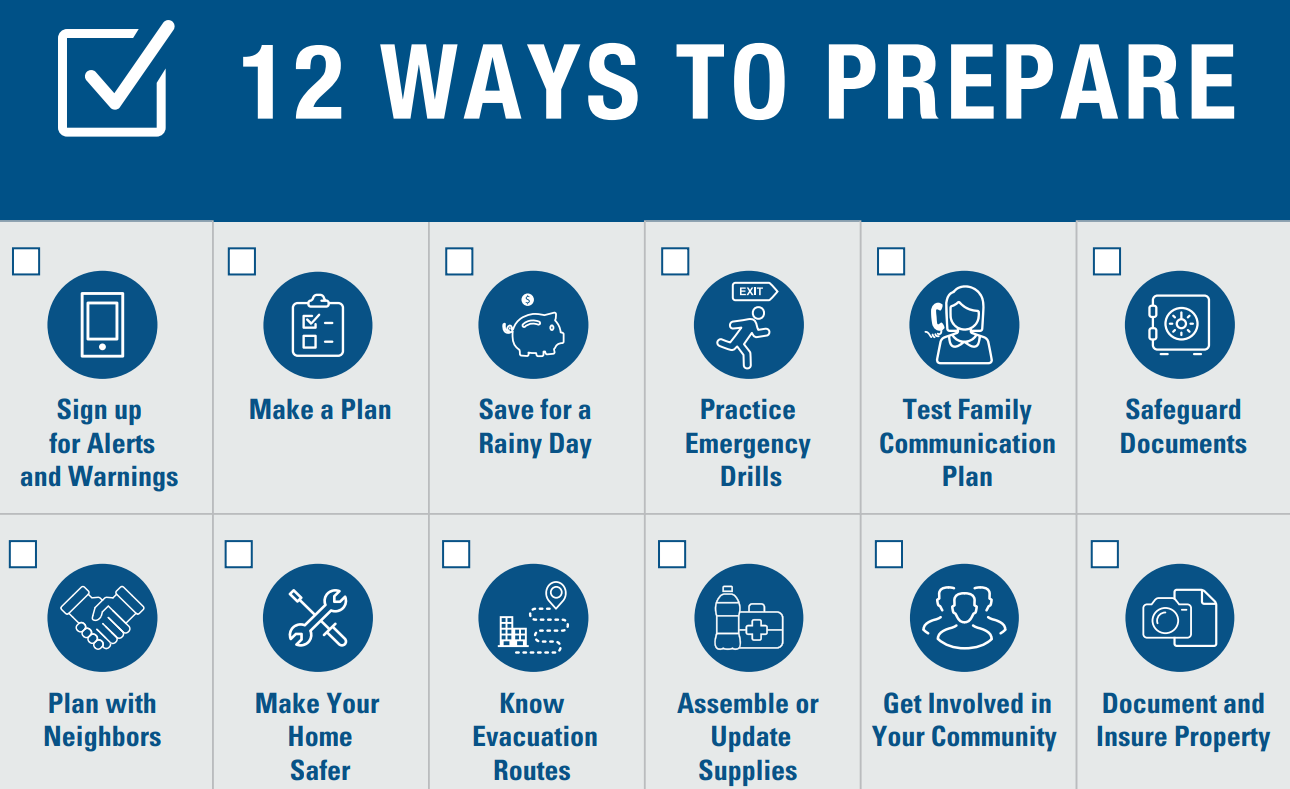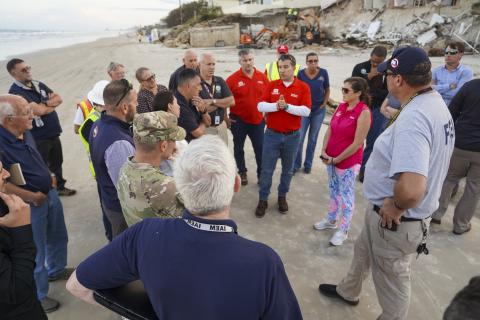FEMA's mission is to help people before, during and after disasters. Here's what you can expect from FEMA in each stage.
Jump to:
Before a Disaster Occurs
During Disaster Response
After a Disaster
Before a Disaster
We work across the country every day before disasters happen to help people and communities understand and prepare for possible risks.
Promoting Preparedness
We work with individuals and communities to build a culture of national preparedness through active community engagement, trainings and education, and planning.
Our national Ready campaign gives you the information and tools to be proactive and prepare for potential emergencies and disasters.


Visit Ready.gov to learn more.

The FEMA App also makes it easy to plan for common hazards with simple slideshows that walk you through the steps to prepare.
Knowing Your Flood Risk
Floods can happen anywhere and are the most-common type of disaster. We can help you determine your flood risk and provide tools and resources, including flood maps, to help you take steps to protect your home.
The National Flood Insurance Program (NFIP) is managed by FEMA. You can learn more about getting a flood insurance policy by visiting FloodSmart.gov.
We also work with communities to manage flood risk through floodplain management and support coordination across all levels of government to protect citizens and property from flooding.
Helping Communities Become More Resilient
We help communities become more resilient through emergency or disaster-related grant programs. Grants support state, local, tribal and territorial (SLTT) governments, certain private non-profits, individuals and institutions of higher learning in recovery initiatives, research and more.

FEMA provides training and education to equip the whole community with disaster preparedness knowledge and skills.
During a Disaster
FEMA coordinates the federal response to disasters that receive a Presidential disaster declaration. We work closely with officials in states, Tribal Nations, and territories as they respond to disasters and make requests for federal support.
Disaster Declaration Process
When a disaster strikes, local government officials review the damage to determine the extent of the incident and its impact. If the state, Tribal Nation, or territory determine they need federal assistance, they submit a request for a federal disaster declaration.
All emergency and major disaster declarations are made solely at the discretion of the President of the United States through the Robert T. Stafford Disaster Relief and Emergency Assistance Act.
- Learn more about how a disaster gets declared.
- Look up recent disaster declarations.
How a Disaster Gets Declared
Types of Declarations
There are two types of disaster declarations provided for in the Stafford Act: emergency declarations and major disaster declarations. The type of declaration affects what types of assistance may be available.
Major Disaster Declarations
The President can declare a major disaster for any event that has caused damage beyond the combined response capabilities of state and local governments.
A major disaster declaration provides a wide range of federal assistance programs for individuals and public infrastructure, including funds for both emergency and permanent work.
Emergency Declarations
The President can declare an emergency for any occasion or instance when federal assistance is needed to supplement emergency services provided by state and local or Indian tribal governments. These services include the protection of lives, property, public health, safety, or to lessen or avert the threat of a catastrophe.
Disaster Assistance
Different disaster assistance programs are available for individual citizens and public groups, such as government agencies and private nonprofit organizations.
Individual Assistance
If you are affected by a disaster and live in an area designated for Individual Assistance under a major disaster declaration, you can apply for Individual Assistance for support during the immediate response of an incident and afterward in the recovery process.
There are many types of assistance programs available to help survivors after a disaster for needs like emergency sheltering, home repairs and hazard mitigation.

Visit DisasterAssistance.gov to apply for disaster assistance, check the status of an application, or to get more information about types of disaster assistance available.
Public Assistance
Our Public Assistance Program provides supplemental grants to state, tribal, territorial, and local governments, as well as certain types of private non-profits, to respond and recover from emergencies or major disasters.
The program helps communities cover costs for debris removal, life-saving emergency protective procedures, and restoring public infrastructure. Public Assistance hazard mitigation funding helps communities build back better and reduce future disaster loss.
Response In the Field
Disaster Survivor Assistance
When a disaster is declared in your area, you may see Disaster Survivor Assistance Teams canvassing communities to register people for disaster assistance, provide in-person information and referrals to help.

Disaster Recovery Centers
FEMA Disaster Recovery Centers are accessible facilities and mobile offices in convenient areas for survivors. At these centers, you can learn more about FEMA and other disaster assistance programs, register and get status checks on your case, and get answers or resolve problems.
Next Steps After Applying for Assistance
After you apply for assistance, we work with you to determine the next steps and the types of assistance you may be eligible for.
Look through a list of Frequently Asked Questions about assistance programs and the disaster recovery process.
After a Disaster
Supporting Recovery
We support state, local, tribal, and territorial government officials who are primarily responsible for managing their communities' disaster recovery with recovery resources. These resources include recovery roadmaps, community management toolkits, and a recovery and resilience resource library to maintain whole community recovery.
The National Disaster Recovery Framework enables a whole community approach and allows agencies to coordinate with each other to provide communities with unified federal assistance as quickly and effectively as possible.

Mitigating Future Hazards
After a disaster, we help communities rebuild stronger to reduce future disaster losses and become more resilient.
Learn what it means to be resilient, or get inspired by the collection of stories and case studies of communities taking action to build back stronger.
The Hazard Mitigation Grant Program is available after a presidentially declared disaster and helps fund risk reduction projects such as:
- Planning & Enforcement
- Flood Protection
- Retrofitting
- Construction


